
JuJu Smith-Schuster, Rob Gronkowski among skill players playing through rib injuries
By Dr. Matt Provencher
FOX Sports Injury & Performance Analyst
It started in Week 2 when Tua Tagovailoa was hit by Buffalo Bills defensive end A.J. Epenesa.
The Miami Dolphins quarterback was removed from the game. Eventually, he was placed on the injured reserve with fractured ribs. The earliest he can return is Week 6.
But it didn’t stop there.
Cardinals receiver DeAndre Hopkins, Steelers receiver JuJu Smith-Schuster, Cowboys receiver Amari Cooper, Buccaneers tight end Rob Gronkowski and Rams running back Darrell Henderson have all dealt with rib injuries in the early going this season.
Unlike Tua, none of them have gone on the injured reserve. Henderson missed last week’s game against Tampa Bay, but he’s expected to play on Sunday against Arizona. In fact, there’s a chance all of them – aside from the Dolphins QB – will play this weekend.
Dr. Matt breaks down JuJu Smith Schuster's injury outlook
But what can we expect from these players? Will it be business as usual or will their production take a hit? How hard is it to play football with a rib injury, and what precautions can be taken to protect against further injury?
Let’s dive in.
For more analysis of the NFL from Dr. Matt, follow him on Twitter or go to FantasyPredictors.com.
Missing time
The core and rib cage are important for skill position players – which includes each of the players we’ve mentioned – because they require extensive core strength to throw, catch and carry the ball, let alone twist their bodies to make plays against the defense. The rib cage is particularly important because it stabilizes the scapula and shoulder.
The data shows that when a player has one or two injured ribs, they will miss an average of 1-2 games. Quarterbacks tend to take a bit more time to take the field, on average missing 3.5-5 weeks.
If a player has more than three broken ribs, you’re looking at a longer absence – 4-8 weeks depending on the position – because it takes longer to heal and the core is more unstable.
Production takes a hit upon return
When players return, production usually drops. How much will it drop? That depends on the player’s position, as well as the severity of the injury.
For a player with fewer than three injured ribs, quarterbacks tend to experience a 3-5% drop in production in their first three games back, while running backs are about 5% less productive and receivers are down 6-8%.
If they have three or more injured ribs, the numbers are 8-12% for quarterbacks, 8% for running backs, 10% for receivers.
Why the dropoff? The muscles between the ribs (intercostal muscles), the serratus anterior and other core muscles are all important for stabilizing and holding the ball (running backs), catching the ball (receivers), and throwing the ball (quarterbacks).
The reduced production has been evident this season in the players we mentioned earlier.
For example, Hopkins took the field for the Cardinals in Week 3, but was almost more of a decoy than his usual dominant self, catching just three of his six targets for 21 yards.
Cooper is another great example. The Cowboys receiver powered through his rib injury on Monday night against Philadelphia, yet caught only three of his four targets for 26 yards.
Smith-Schuster injured his ribs during Sunday’s game against Cincinnati and did not return. His practice time was limited this week, so it wouldn’t be surprising to see his production – like that of Hopkins and Cooper – be similarly limited on Sunday if he does play.
The dangers of re-injury
Because these muscles and the ribs themselves are so important to all of these key movements in skill positions, reinjury is a concern.
You can try to protect the players’ ribs to some extent by using Cover Roll tape, as well as padded protections like Kevlar jackets, high-density foam products and some shirts.
But even so, the rate of re-injury can be as high as 18-22%, depending on the player.
Without being given time to properly heal – which can be difficult to do when you’re in the thick of a season – the prospect of re-injury, as well as reduced production, are of concern. But if a player feels like he can play through the pain, he’s going to push to take the field.
For more up-to-date news on all things NFL, click here to register for alerts on the FOX Sports app!











